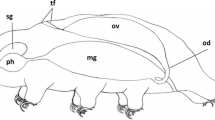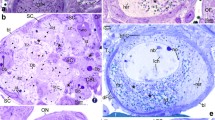Abstract
A SMALL piece of ovary of a very young pigeon was kept for about twenty minutes in a trough of dilute solution of neutral red, just pink in colour (strength—1/25000 physiological salt solution). It was then teased out and examined under an oil immersion lens in artificial light. The young oocytes showed a nucleus and a thick granular mass at one end of the nucleus in the general cytoplasm (C. F. D'Hollander's “yolk nucleus of Balbiani” observed with classical methods). In this area particularly, in more advanced oocytes, could be seen the following three structures (Fig. 1).
Similar content being viewed by others
Author information
Authors and Affiliations
Rights and permissions
About this article
Cite this article
BHATTACHARYA, D., DAS, R. Golgi Body and Vacuome. Nature 124, 692–693 (1929). https://doi.org/10.1038/124692b0
Issue Date:
DOI: https://doi.org/10.1038/124692b0
- Springer Nature Limited





